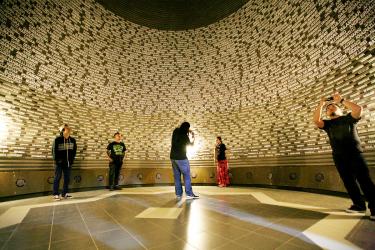Powerful quake in South Pacific triggers 3-foot tsunami - World News
Powerful quake in South Pacific triggers 3-foot tsunami
By Becky Bratu, Staff Writer, NBC News
A 3-foot tsunami was generated after a strong earthquake shook the islands in the South Pacific, the Pacific Tsunami Warning Center said.
Follow @NBCNewsWorld
The U.S. Geological Survey says the quake -- with a preliminary magnitude of 8.0 -- struck Wednesday in the Santa Cruz Islands at a depth of about 3 miles. The Santa Cruz Islands are scarcely populated and are part of the Solomon Islands.
A magnitude 6.4 aftershock occurred shortly after the first rumble, followed by a 6.6 one later. USGS officials said that was "not at all surprising."
Hotel workers on Vanuatu said they felt the earthquake but have not heard of any damage or injuries. An employee who can see the coast from a hotel said he had not noticed any water coming in.
The tsunami warning was in effect for the Solomon Islands, Vanuatu, Nauru, Papua New Guinea, Tuvalu, New Caledonia, Kosrae, Fiji, Kiribati, Wallis and Futana. A tsunami watch was in effect for Samoa, New Zealand, Australia, Indonesia and Guam.
Powerful quake in South Pacific triggers 3-foot tsunami
By Becky Bratu, Staff Writer, NBC News
A 3-foot tsunami was generated after a strong earthquake shook the islands in the South Pacific, the Pacific Tsunami Warning Center said.
Follow @NBCNewsWorld
The U.S. Geological Survey says the quake -- with a preliminary magnitude of 8.0 -- struck Wednesday in the Santa Cruz Islands at a depth of about 3 miles. The Santa Cruz Islands are scarcely populated and are part of the Solomon Islands.
A magnitude 6.4 aftershock occurred shortly after the first rumble, followed by a 6.6 one later. USGS officials said that was "not at all surprising."
Hotel workers on Vanuatu said they felt the earthquake but have not heard of any damage or injuries. An employee who can see the coast from a hotel said he had not noticed any water coming in.
The tsunami warning was in effect for the Solomon Islands, Vanuatu, Nauru, Papua New Guinea, Tuvalu, New Caledonia, Kosrae, Fiji, Kiribati, Wallis and Futana. A tsunami watch was in effect for Samoa, New Zealand, Australia, Indonesia and Guam.




